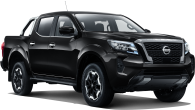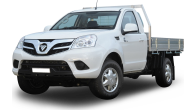Accepted wisdom in dual cab utes is that you need leaf-spring rear suspension to be taken seriously as a heavy load-hauler. The Nissan Navara and its Mercedes-Benz X Class derivative prove this age-old theory is correct, with their coil-spring rears displaying shortcomings under maximum payloads during CarsGuide testing.
Ssangyong launched its latest generation Q200 series Musso dual cab ute in 2018, also with a coil-spring rear. However, in 2019 the Korean manufacturer has given Musso some serious workhorse cred by releasing a longer wheelbase version called the XLV (Xtra Long Vehicle?) with a bigger load tub, leaf-spring rear suspension and one-tonne payload rating. We recently put one to work to see if the long wait for this new variant has been worth it.
Ssangyong Musso XLV 2019: Elx
| Engine Type | Diesel Turbo 4, 2.2L |
|---|---|
| Fuel Type | Diesel |
| Fuel Efficiency | 8.9L/100km (combined) |
| Seating | 5 |
| Price From | $19,690 - $24,860 |
Does it represent good value for the price? What features does it come with?
Our test vehicle is the Musso XLV ELX with optional six-speed automatic transmission for $35,990. The ELX is the work-focused base model in a three-tier XLV line-up that includes mid-level Ultimate and top-shelf Ultimate Plus.
This is a lot of truck for less than $36K when compared to market-leading dual cab 4x4 auto rivals that are $10K more, like Toyota's work-focused HiLux WorkMate ($46,865) and Ford's Ranger XL ($46,440).
.jpg)
However, the ELX doesn't look like a base model with its 17-inch alloy wheels and 235/70R17 tyres with a matching spare. There's also plenty of useful kit like the quality infotainment system with 8.0-inch HD control screen, steering wheel-mounted controls and multiple connectivity including Apple CarPlay, Android Auto and Bluetooth.
ELX buyers also get carpet, keyless entry, cruise control, limited slip diff, rear-view camera, daytime running lights and numerous dynamic safety features headlined by AEB. Our test vehicle is also fitted with a tow-bar and electronic brake controller.
Is there anything interesting about its design?
The Musso XLV's interior and polarising exterior styling is based on Ssangyong's Rexton SUV. It looks big and imposing because it is and that's largely due to the XLV's stretched load tub which Ssangyong claims is now the longest in class. The XLV is 43mm longer overall than a Ford's big bruiser Ranger XL dual cab 4x4 and also close in width and height.
Like its SWB Musso stablemate, the XLV has rugged body-on-frame construction, dual wishbone coil-spring front suspension and four-wheel disc brakes. The new leaf-spring live rear axle also brings with it a stretch in wheelbase, which at 3210mm is 110mm longer than the SWB version. This improves load distribution, directional stability and ride quality. Off-road credentials include 215mm of ground clearance, 25 degrees approach angle and 20 degrees ramp-over and departure angles.
The doors close with a solid thud and there's a high standard of finish inside and out. Although it's a work-focused base model, the interior of the ELX doesn't have the usual bare-boned look and feel expected at this level, with carpet and a tasteful blend of surface treatments including chrome, satin chrome and piano black.
.jpg)
The front seats are comfortable but the driver's base cushion could use some rake adjustment as it can feel like you're sliding off the front of it at times. Fortunately, there's a huge left footrest to offset this effect.
Like the SWB Musso, the XLV's rear doors are only 50mm shorter than the fronts resulting in easy rear seat entry/exit and ample leg and head room, even for tall adults. The unloved centre rear seating position offers an unusually high level of comfort for a dual cab, but is spoiled somewhat by only having a lap seat-belt. This needs to be addressed pronto.
Other negatives are the hard plasticky feel of the steering wheel rim which lacks grip, the absence of grab handles on the windscreen pillars and lack of a headboard frame at the front of the load tub to protect the rear window and provide support for carrying long lengths of timber, PVC or copper pipe etc.
What are the key stats for the engine and transmission?
The e-XDi220 engine, manufactured by Ssangyong, is a Euro 6-capable but in this case Euro 5-compliant 2.2 litre inline four-cylinder turbo-diesel offering excellent performance and economy.
It produces a class competitive 133kW at 4000rpm and 420Nm across a broad 1000rpm torque band between 1600-2600rpm. Refinement and quietness of operation are outstanding.
.jpg)
It's matched with a slick-shifting Aisin six-speed torque convertor automatic, with overdrive on fifth and sixth gears for economical highway driving and the option of sequential manual shifting using the toggle switch on the side of the shifter knob. There's also three driving modes available – Eco, Power and Winter - with different shift protocols to suit.
The 4x4 transmission is part-time dual range with 2.483:1 low-ratio reduction. For efficiency and economy in 4x4 mode, engine power is delivered to the rear wheels with the fronts coming into play only when needed via electronic control. The rear axle is equipped with a limited-slip diff aided by electronic traction control.
How much fuel does it consume?
Ssangyong claims a combined average of 8.9L/100km. After 560km of testing, with only light loads in mostly suburban and city traffic, the dash display was showing 10.2 when we stopped for our first tank refill. However, our figure based on fuel bowser and tripmeter readings was only 7.9, which is outstanding economy for a one-tonne ute.
Our second test was with maximum payload over a distance of almost 200km, which comprised mainly highway and dirt roads with a bit of city work. Our figure this time climbed to 9.6, but that's still excellent single-digit economy given the load it was carrying.
So, based on our higher consumption figure, you could expect a realistic driving range (with a big load too) of around 780km from its 75-litre tank.
How practical is the space inside?
The XLV's 2210kg kerb weight and 3220kg GVM results in a one-tonne-plus payload rating of 1010kg. It's also rated to tow up to the category-benchmark 3500kg of braked trailer. However, to do that, the payload would have to be reduced by a massive 510kg - or effectively halved - to avoid exceeding the 6220kg GCM (or how much you can legally carry and tow at the same time).
That would leave only 500kg of payload to play with, which could easily be used up by five adults with no luggage. That would be totally impractical of course, so our advice is always to base towing limit on GVM. In this case 3220kg, which would lower the braked towing capacity to 3000kg (more than ample for most towing requirements anyway) and give you back the full 1010kg of payload.
.jpg)
The XLV's longest-in-class load tub has square internal dimensions of 1610mm length and 1610mm width measured at the top edges. Combined with its 580mm depth, that results in a spacious 1262 litres of load volume. There's enough room between the wheel housings to take an 800mm-wide Euro pallet as well, but not the larger 1165mm-square Aussie version.
There's also a load anchorage point in each corner, located at floor level where they should be, plus a handy 12-volt/120W accessory outlet. Our test vehicle was also fitted with a full protective tub-liner.
.jpg)
Cabin storage includes a bottle holder and storage bin in each front door plus a shallow oddments tray in the centre dash-pad, an overhead glasses holder and lockable glovebox. The centre console has a small storage tray up front with USB, auxiliary jack and 12-volt outlets, plus two cup holders in the centre and a storage box with padded lid at the back.
There's also a bottle holder and storage bin in each rear door, plus flexible storage pockets on each front seat backrest and two cup holders in the fold-down centre armrest. The rear bench seat base is fixed but there's handy space underneath for storage of soft items like small bags, jackets etc.
.jpg)
What's it like as a daily driver?
SSangyong told CarsGuide that it's developing a unique Australian suspension package for the Musso XLV tailored to better suit local requirements. That should be available in late 2019, so until then all XLVs feature the same 'Korean' specification as fitted to our test vehicle.
When empty or with light loads, on a variety of bitumen and dirt roads, the ride quality is commendably smooth for a leaf-spring live rear axle, assisted no doubt by the longer wheelbase and supple sidewalls of its 17-inch tyres. The steering is also responsive and nicely weighted and braking from the four-wheel disc brakes is strong and consistent.
NVH levels are also impressive, particularly at highway speeds with low engine, tyre and wind noise allowing conversations without raised voices. At 100km/h the low-stressed turbo-diesel is doing only 1500rpm at 100km/h and 1700rpm at 110km/h. In city and suburban driving it's usually operating within its 1600-2600rpm peak torque band too, providing spirited acceleration in the commonly used 40-80km/h speed range. Overall, as a daily driver it's comfortable, economical and hard to fault.
What's it like for tradie use?
With 890kg secured in the load tub plus our 100kg driver, the 990kg payload was only 20kg under the 1010kg legal limit. However, the rear suspension compressed almost 80mm, which was excessive for a leaf-spring set-up and left barely 10mm of bump-stop clearance. The thud of bump-stop rubbers contacting chassis rails could be regularly felt throughout this portion of our road test.
.jpg)
Even so, the XLV's refined power-train excelled on our 13 per cent gradient 2.0km set climb with this big payload on board, easily pulling third gear at 2200-2400rpm all the way to the top. Engine braking on the way down, in a manually-selected second gear, wasn't as impressive thanks to the Aisin auto. After reaching 3800rpm on overrun, it suddenly over-rode our manual gear selection and shifted up to third, even though the 4500rpm redline was still a long way off.
These engine-protecting shift protocols are becoming increasingly common in LCV auto transmissions these days. However, they can give you a nasty surprise if you're relying on engine braking to assist during a steep descent with a heavy payload and it suddenly shifts up a cog and starts running away from you.
.jpg)
Warranty & Safety Rating
What safety equipment is fitted? What safety rating?
No ANCAP rating but it does have AEB and other active features like forward collision warning, lane departure warning, front vehicle start alert (a sign of these device-obsessed times), electronic brakeforce distribution and traction control. There's also driver and front passenger airbags, front-side and rear-side curtain airbags and three child seat anchorage points for the back seat, but no ISOFIX and only a lap belt for the centre passenger. There's also a standard reversing camera, but it was not working during our test.
What does it cost to own? What warranty is offered?
Seven year/unlimited km warranty. Service intervals of 12 months/15,000km. Capped-price servicing of $375 for first seven scheduled services up to seven years/105,000km whichever occurs first. Also seven years of complimentary roadside assist, if serviced on schedule by a SsangYong dealer.
Verdict
Although there's no ANCAP rating or centre rear lap-sash belt, the Musso XLV has upped Ssangyong's appeal to work-focused buyers with its huge load tub and leaf-spring rear suspension.
However, the rear springs are clearly too soft for the GVM rating and need upgrading. Hopefully this will be part of the locally developed Australian suspension package, which we'll be eager to test when it becomes available.
If Ssangyong can get that right, the XLV could be just what budget-conscious Aussie workhorse buyers are looking for. At less than $36K, with such a generous warranty, that's a no-brainer.
Range and Specs
| Vehicle | Specs | Price* |
|---|---|---|
| Elx | 2.2L, Diesel, 6 SPEED AUTOMATIC | $19,690 - $24,860 |
| Elx | 2.2L, Diesel, 6 SPEED MANUAL | $14,960 - $19,690 |
| Ultimate | 2.2L, Diesel, 6 SPEED AUTOMATIC | $22,330 - $27,610 |






.jpg)
.jpg)
.jpg)
.jpg)
.jpg)
.jpg)
.jpg)











_0.jpg)
.jpg)
.jpg)


.jpg)
